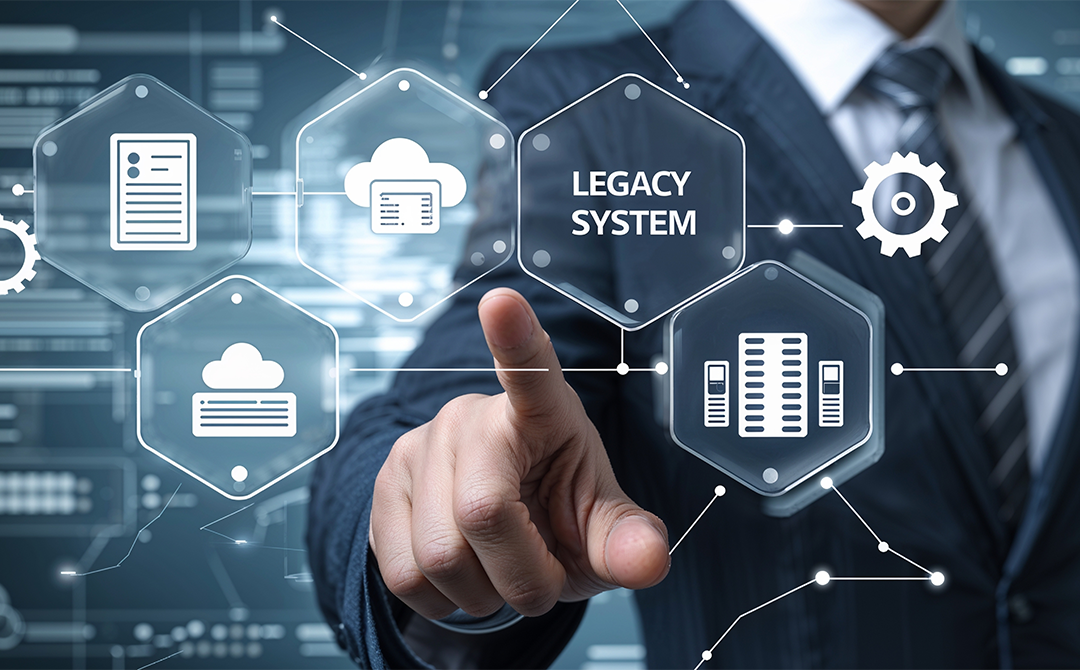
You must’ve already know by now that AI isn’t a futuristic sci-fi concept anymore. The tech space has undergone a significant transformation in the past few years, as AI continues to permeate nearly all domains and become an integral part of real business operations across various industries. In 2025, the big question for companies isn’t whether they should adopt AI, but how they can make it work with the systems they already have.
70% of software in Fortune 500 companies is over two decades old (McKinsey).
Due to outdated AI legacy systems, unorganized data, ethical concerns, budget constraints, and AI business integration incompetence, a lot of companies still run on traditional systems. As a result, the demand for AI integration services and AI integration specialists is rising rapidly.
With the right tech-stack and a clear plan, companies can push ahead without getting stuck in complexities.
If bringing AI into your work feels like too much, don’t worry, you’ve got this. With the right guidance, the shift can feel straightforward and well-organized, like following clear signs on an open road, helping your business move ahead without hitting obstacles.
This guide helps CIOs, IT leaders, and digital transformation leads to tackle AI legacy system modernization confidently. The guide also covers AI integration strategies, future trends, and more. Let's dive deeper.
What Is AI Integration? Understanding the Concept & Business Rationale
Before we get into integration of AI, let’s get some obvious basic stuff clear. Digital transformation is about moving from manual processes and paperwork to digital platforms like apps, platforms, and online systems that improve efficiency and customer access. AI transformation takes that a step further. It’s about making businesses intelligence-driven: using data and algorithms so systems can learn, adapt, and even make decisions.
AI integration is the process of embedding machine learning, NLP, and computer vision, or GenAI models into your existing frameworks (ERPs, CRMs, mainframes, etc). This lets the AI sift through data quickly, then uncover insights using machine learning and deep learning. When you plug AI into your existing non AI legacy systems, it can spot patterns in your data like repeated customer questions, then automate tasks, make predictions, and fine-tune how everything runs. Whether it’s predictive analytics guiding sales teams, NLP powering better customer service, or ML models optimizing operations, AI integration helps empower organizations to automate processes, discover new insights, and drive innovation.
For example, think of AI chatbot integration. By connecting a chatbot with your CRM, customer queries can be answered instantly with context from past interactions, without waiting for support ticketing. Take AI and machine learning in supply chains, models can sift through years of shipping records to spot patterns, forecast delays, fine‑tune inventory, and cut costs.
Why Modernizing Non-AI Legacy Systems Is Critical in 2025
53% of IT executives say that between one-quarter and half of their technology estate is legacy, and 83% plan to upgrade their system. (Source)
Most businesses today face a hard truth: their data has grown far past what their systems can handle. But people have started to expect instant answers and seamless experiences.
It is safe it say that companies that still run on non-AI legacy systems offering little visibility into what’s happening in real time are holding business back. This is where AI integration in business plays a key role. According to Gartner, AI integration can reduce costs by up to 70% by 2027(Source).
AI does not mean starting from scratch. Instead, it integrates with your existing legacy systems, augmenting and scaling your infrastructure where it is needed most. This means faster data processing, smarter analytics, smoother daily operations, and much more—integration without a complete system substitution. Companies are now able to fully modernize their processes in a cost efficient manner, real-time decision making and insights once thought to be impossible is now a reality. Businesses can analyze, act, and predict with their data. With enhanced analytics, AI improves interoperability and ensures systems communicate more effortlessly, creating a more scalable, future-ready configuration that grows with the business. The outcome is smarter operations with significant cost savings and the ability to compete in a rapidly evolving digital market. All these without starting from scratch. Everything in place. Everything integrated. Everything operational.
AI can plug into existing non-AI legacy systems infrastructure, fill the gaps, and up-scale platforms. This offers faster processing, smarter analytics, and smoother operations not having to start from scratch. Companies that have used AI to modernize their systems have seen faster data processing and major cost reductions.
Step-by-Step Framework to Integrate AI with Your Legacy IT Stack
Common thought among businesses is that bringing AI into non-AI legacy systems can be an uphill task. But it need not necessarily be that. Most businesses already have systems that work; they just need a push to work smarter. AI can provide that push if you bring it in carefully. A practical way to approach this is to break it down. Start with your data, clean it up, and see what’s usable. Try out models in a test setup instead of going live right away. Then roll things out bit by bit. This way, daily operations keep running while you slowly add AI where it makes sense.
Step 1: System audit & data assessment
Start by looking at what you’ve got. Most non-AI legacy systems are full of data, but half of it might be messy or outdated. Before you think about AI, clean up what’s useful and drop what isn’t. Good data makes everything else smoother.
Step 2: Identify AI use cases (forecasting, anomaly detection, NLP, etc)
AI can do a hundred things, but you don’t need all of them. Maybe your business could use sales forecasting, maybe it’s fraud detection, or maybe it’s just a chatbot to handle customer queries so your team gets fewer repetitive calls. Some businesses might have multiple requirements, hence find use cases that suit your requirements.
Step 3: Choose AI integration tools (ETL platforms, APIs, Connectors)
Non-AI legacy systems weren’t exactly built keeping AI in mind. But that’s okay. Tap into APIs, ETL tools, or pre-built lightweight connectors that sync AI tools with non AI legacy systems you already use.
Step 4: Model development + testing with a sandbox
Before deploying into your non-AI legacy systems, test it in a sandbox first. See how it treats your data, run a quick test, adjust anything that feels wrong, and move ahead only when you’re sure.
Step 5: Gradual deployment & model governance
You need not flip the switch across non-AI systems in your company on day one. You can start small from one team or one process, see how it performs, and then expand. Keep rules simple: who manages updates, how often data gets refreshed, and how you’ll handle mistakes.
Step 6: Continuous improvement & Monitoring
Models drift over time, data changes, and business needs can pivot overnight. Watch it closely, retrain when it starts slipping, and tweak small things as you go. That’s what keeps your system relevant.
Industry Use Cases and Real-World Examples
Industries are using AI to streamline operations and enhance customer experience. From AI and telecom integration for automated network management to AI integration in healthcare for faster diagnostics, real-world examples showcase its transformative impact.
Banking & Financial Services
-
HSBC – Smarter fraud and money-laundering monitoring
HSBC paired up with Google Cloud to build an AI-powered system that scans around 900 million transactions a month and spots suspicious activity faster than its non-AI legacy system with fewer false alarms. That means fewer wasted investigations and quicker fraud detection. It’s catching 2–4 times more issues but with 60% fewer false positives. (Source)
-
Deutsche Bank – Smarter compliance and reporting
In May 2025, Deutsche Bank started working with Singapore’s finaXai to explore how machine learning and large language models can support tokenized fund servicing. This was part of the bank’s Project DAMA 2 pilot, aiming to improve how asset managers handle tokenized funds, without tearing down their existing systems. (Source)
Healthcare
-
Valley Medical Center and OSF healthcare
The Valley Medical Center uses an AI tool called Xsolis Dragonfly to better score which cases needed clinical escalation. It helped staff review more cases faster, cut unnecessary steps, and freed up nurses to focus on issues that mattered most. Observations jumped from 4% to 13%, and extended observation rates went up 25%. OSF Healthcare uses an AI “digital front door” called Clare, which is a 24/7 assistant on their website. Patients could check symptoms, schedule appointments, and get general info without get in touch with a staff. This freed up the call center, saved around $1.2 million, and even boosted revenue by the same amount. (Source)
Tredence’s “agentic AI” in healthcare automates various tasks. These AI agents do things perform appointment scheduling, patient prioritization, and help clinicians with diagnostic suggestions by analyzing EHR data, genetic profiles, and lifestyle factors.
Retail & Logistics
-
Target, Walmart, and The Home Depot
Big retailers are moving away from brittle, siloed inventory systems, and non-AI legacy systems. Target, for instance, uses a system called Inventory Ledger that blends sales data, shipping times, promotions, and local factors to predict demand. This has doubled the number of products it monitors in just two years. On top of that, it spots misplaced stock and forecasts trends before they actually happen. Walmart and The Home Depot are following a similar path by tailoring stock to regional demand and improving shelf availability. The result? A smoother shopping experience and better control over inventory. (Source)
Manufacturing
-
TechnoFab Industries
TechnoFab, an automotive parts maker with a dozen factories, integrated sensors, edge computing, and machine learning into its ERP. They saw a 75% drop in downtime, 30% lower maintenance costs, and a huge improvement in equipment reliability. Unplanned machinery breakdowns cost companies worldwide up to $1.4 trillion a year. AI-based predictive maintenance platforms now let teams catch issues before they happen. These tools pair IoT data with analysis so technicians can prevent downtime and even get insights from LLMs. (Source)
Key Challenges in AI Legacy System Integration
AI legacy systems integration can very rarely be simple. That’s why many organizations hit roadblocks that stall adoption and limit AI’s impact. Here are some of the hurdles companies run into with AI system integration, things like merging it with old non AI legacy systems or training teams to use it well:
Data challenges
Many companies still deal with siloed data spread across multiple systems and unstructured formats in their non-AI legacy systems. This makes AI training difficult. Without a unified view, insights will continue to remain fragmented.
Architecture limitations
Non-AI legacy systems and platforms lack modern APIs or the flexibility to work with MLOps pipelines. This creates friction when AI models need to connect with existing workflows or scale into production.
Human factors
More than a technological update, human adoption also plays a major role in AI integration in your non-AI legacy systems. A shortage of in-house expertise and resistance to new ways of working slow down progress.
Security and compliance risks
When sensitive data flows between non-AI legacy systems and AI platforms, organizations can get exposed to regulatory risks and trust issues due to gaps in governance.
A Solutions playbook
How do companies succeed, then? There’s a simple answer to that. Companies that succeed with AI integration into non-AI legacy system usually follow a phased approach. They start with strong data governance, data cleansing, and consolidation before model training. They roll out AI gradually, testing in controlled environments before scaling. Upskilling teams and addressing change management are as important as the technology itself. Most importantly, selecting the right partners with proven AI accelerators and integration expertise can help avoid reinventing the wheel.
That’s where Tredence steps in. Tredence’s domain-specific accelerators and pre-built solutions enable enterprises to overcome challenges in the integration process with non-AI legacy systems.
Best Practices for Seamless System Integration
Here are some of the proven practices that organizations follow to make system integration smoother and reduce disruptions in their AI legacy system.
Work with an AI integration specialist
Organizations can work with experienced integration professionals to help avoid common pitfalls. Their expertise ensures smoother rollouts, reducing costly trial-and-error.
Use data-centric AI models with explainability
An organization can focus on data quality since clean and structured data improves system performance, improving decisions.
Start small - pilot integrations with clear results
Getting started with full-scale integration can overwhelm even the best of the teams and systems. So, it is best that enterprises start with small pilot projects that deliver measurable results. This allows businesses to build confidence before expanding.
Keep humans in the loop: Augmented decision making over full automation
Systems work best when they work under human judgment. AI integration should aim at improving decision-making and freeing up teams for higher-value work.
Build governance frameworks for AI systems integration
Ensure integrations remain compliant, secure, and aligned through strong policies, checks, and controls. Governance frameworks offer clarity when scaling across multiple systems.
With a strategic approach, organizations can move past the initial hurdles and build scalable systems aligned with business goals.
Measuring Success: KPIs & ROI from AI Integration Initiatives
A Microsoft-sponsored IDC report finds organizations achieve, on average, a 3.7× ROI from generative AI investments within the first 18 months. Top performers report an even more impressive 10.3× ROI per dollar spent. Source.
Once an AI system is up and running, organizations should check whether it is working the way it should. To know that we need clear metrics that show both technical performance and business value. And how do we do that?
1. Track the Model performance
Check how the system is performing and its results. Ensure it responds quickly and avoids overtime. These checks help ensure the system stays reliable and relevant.
2. Measure Business KPIs
Measure business results by measuring cost savings and process speeds. If higher-value tasks are prioritized over routine work, that’s a sign the integration is paying off.
3. User adoption & satisfaction
Track adoption and employee satisfaction. Gathering feedback regularly helps fine-tune the integration and also helps improve the value.
4. Compliance and audit-readiness
Compliance and audit-readiness are important as as speed or business success. A well-integrated system should support these requirements without creating extra headaches.
Best Practices & Expert Recommendations
Identifying the right methods for effective AI integration with a clear strategic approach can be challenging. Here are some of the best practices and expert recommendations to guide you:
1. Engage AI Integration Consulting or Specialists Early
Start by finding the specific goals of your AI integration efforts. Working with AI specialists can give me an advantage. They can help you identify the use cases, identify requirements, and improve decision-making. Early expert input can save months of trial and error.
2. Start with High-Impact, Low-Risk Pilots
Start with simple projects that deliver clear business results. For example, integrating AI that automates invoice processing, sales teams can spot trends with analytics, track trends with analytics, and make demand forecasts to predict how much stock to order for next month.
3. Monitor, Iterate, and Scale
Once your pilot’s up and running, monitor your results, get feedback, and refine your system until it clicks. When you're sure that the system is running smoothly, you can integrate more teams or even handle extra processes. Test and adjust as you go. This ensures fewer risks and long-term success.
4. Leverage Domain-Specific AI Integration Services
Use integration services for your specific domain. For eg, retail focuses on personalized recommendations, while requirements for a finance enterprise can be different. Therefore, using domain-specific AI integration services ensures the solution is aligned with your business context.
Future Trends in AI Integration: Gen AI, Edge AI & Beyond
By 2026, nearly a third of older non-AI legacy systems will have generative AI built in (Source). As AI advances rapidly, the trends indicate that AI integration is no longer limited to tech-first companies. Enterprises are finding new ways to integrate them into their businesses. Here are some of the key shifts that are shaping the future:
Gen AI Integration with legacy CRMs, chatbots, and knowledge bases
The integration of generative AI into everyday tools like old CRMs and chatbots make them sharper. For example, a sales team with a standard CRM could plug in Gen AI to create customer emails, condense call notes into a few sharp lines, and point them toward the next move, cutting down tedious manual steps.
Edge AI for decentralized processing in manufacturing & telcom
Edge AI speeds things up for various industries. In manufacturing, that means workers can run quality checks on the assembly line the instant each part clicks into place, with no delay. In telecommunications, it speeds up decision-making right at the network’s edge, keeping services steady. Edge AI cuts bandwidth costs, boosts security, and delivers instant responses. This means faster decisions, less latency, and reliability.
Focus on Explainability (XAI) and Trustworthy AI
As generative AI becomes part of core IT systems, the push for explainable AI will surge. To figure out how AI models reach their decisions, organizations will need practical tools and clear methods, especially when dealing with things like spotting a phishing attempt or triggering an automated incident response. This helps earn trust and makes it easier to follow the rules set out in regulatory frameworks.
Rise of self-serve AI integration tools (AutoML + APIs)
Self-serve tools with AutoML and API-powered platforms allow even non-technical teams to use AI in their work without any deep coding. The growth of self-serve tools, AutoML platforms, and ready-made APIs makes AI adoption faster and easier. Business teams can experiment with predictive models, chatbots, or recommendation engines with minimal coding.
Why Choose Tredence for Your AI Integration Journey
If you’ve reached this part of the blog, then you must’ve understood the growth graph of AI in the upcoming years. If you’re a company looking for a head start in the AI space, then you need to understand that AI integration is more than just a tech upgrade. From generative AI in CRMs to edge AI in manufacturing, the future is about smarter, faster, and more adaptive systems that bring real value to people and processes.
If you’re looking to accelerate your journey in generative AI adoption, look no further than Tredence, as we are dedicated to supporting you in that journey. At Tredence, we offer more than integration; we offer accelerator-driven, domain-first solutions aimed at addressing the most difficult operational challenges. From generative AI consulting to UX design, change management, and governance, we offer our expertise and end-to-end ai integration solutions to Gen AI structures that scale. By working with us, you can develop new business strategies, redefine value-chain processes, and scale model development conveniently. Additionally, we offer domain-specific accelerators that are easily customizable and can simplify complex processes.
Let’s turn AI into your competitive edge. Ready to lead the next wave of transformation?
FAQs
1. What is AI integration?
AI integration is the process of embedding artificial intelligence capabilities into your existing business systems, tools, or workflows. Instead of replacing everything, it allows companies to use AI for automation, predictive insights, and smarter decision-making within their current setup.
2. How to integrate generative AI into legacy systems without a complete overhaul?
Generative AI can be integrated into non AI legacy systems using APIs, middleware, and cloud-based AI services. This approach avoids ripping out existing infrastructure and instead layers AI on top of current systems. The goal is to enhance functionality like automating reporting, customer interactions, or data analysis without disrupting operations.
3. What are the top-rated AI data integration platforms?
With the integration of AI technology into data platforms, organizations can consolidate data from different sources, automate processes, and derive actionable insights to make data-driven decisions. Some of the most rated are:
Tredence: A leading AI data integration company, Tredence focuses on industry-centric solutions, providing seamless data ingestion, transformation, and advanced analytics. Their platform applies machine learning to provide quick actionable insights in retail, manufacturing, and health care.
Microsoft Azure Data Factory: A distributed, cloud-native data integration service that allows enterprises to design automated data pipelines, move and transform data at scale, and integrate AI-powered connectors.
IBM DataStage: Part of IBM's DataOps and InfoSphere suite, DataStage allows enterprises to design, develop, and run scalable ETL processes.
All these platforms assist enterprises in wanting to eliminate data siloing, increase AI-enhanced automation of processes, and improve conversational AI technology.
4. How does AI integration differ from a full digital-transformation overhaul?
- AI integration: Adds AI capabilities to existing systems without changing the entire infrastructure. It’s faster, cost-effective, and minimally disruptive.
- Full digital transformation: Involves reengineering processes, upgrading infrastructure, and shifting to entirely new platforms. It’s a broader, long-term strategy with higher costs and longer timelines.
5. How do you measure ROI and success metrics after integrating AI into legacy systems?
We link AI-generated outcomes to business outcomes in ROI. This encompasses operational goals such as spending less money, raising efficiency in business processes, and increasing system uptime, as well as strategic benefits such as improved forecasting and decision-making speed and enhanced overall CX. Adoption rates, time-to-value from AI accelerators, and AI ESG, inventory, revenue, and supply chain enhancements provide additional success measures.
6. How does AI integration differ from a full digital-transformation overhaul?
AI integration to non-AI legacy systems augments and streamlines the current processes and systems without the need for complete redesign, thus still saving time and costs, unlike a full transformation, still less disruptive than revolutionizing the whole system. Instead of completely overhauling legacy systems, AI replaces them with an intelligent layer that enhances data precision, automates workflows, and provides advanced predictive and prescriptive analytics. Other than that, full digital transformation usually means that the core systems and business models have to be completely redone. In contrast, AI integrations ensure a fast approach to results. It sets the foundation to shift to a larger scope of transformation later, if needed.

AUTHOR - FOLLOW
Editorial Team
Tredence
Next Topic
Generative AI & LLM Engineer Careers: Breaking Into Top Tech Roles in 2025
Next Topic




